Culture and Health: Exploring Aboriginal Health and Cultural Factors
VerifiedAdded on 2020/05/04
|9
|2802
|27
Essay
AI Summary
This essay examines the complex interplay between culture and health, focusing specifically on the Aboriginal population in Australia. It explores historical contexts, including the impact of assimilation policies and the mistreatment of Aboriginal children, which have significantly shaped current health disparities. The essay delves into the cultural frameworks influencing Aboriginal health, highlighting the importance of community ties and traditional practices. It analyzes the social determinants of health, such as socioeconomic status, access to healthcare, and educational levels, and their impact on the wellbeing of Aboriginal communities. Specific health issues, including Type II diabetes and cardiovascular diseases, are discussed in relation to lifestyle factors and healthcare access. The essay emphasizes the need for culturally sensitive healthcare practices and the importance of addressing historical injustices to improve health outcomes for Aboriginal Australians. It also references various research studies and government initiatives related to Aboriginal health. The author reflects on their own learning journey and how their understanding of Aboriginal health has evolved throughout the course.
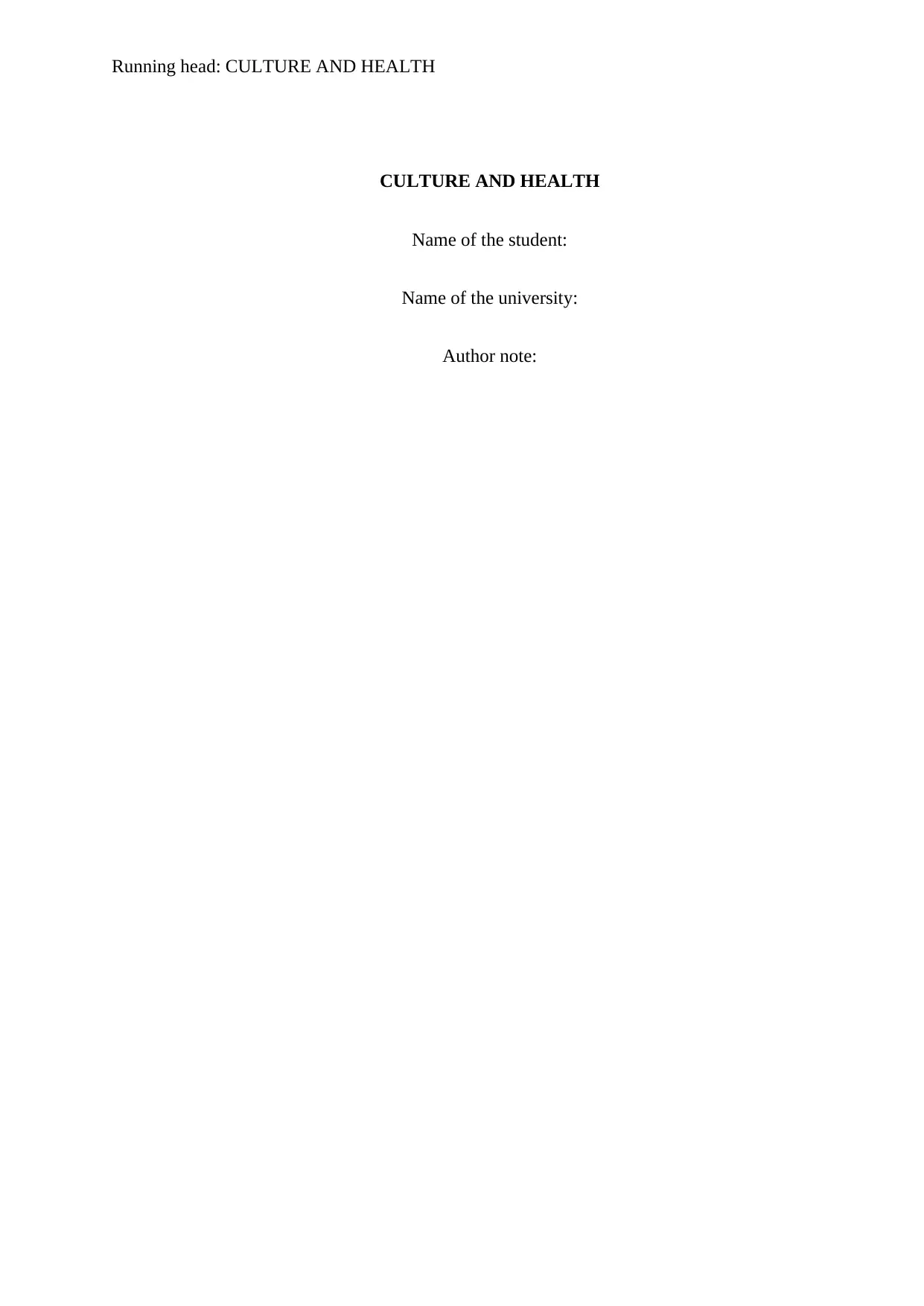
Running head: CULTURE AND HEALTH
CULTURE AND HEALTH
Name of the student:
Name of the university:
Author note:
CULTURE AND HEALTH
Name of the student:
Name of the university:
Author note:
Paraphrase This Document
Need a fresh take? Get an instant paraphrase of this document with our AI Paraphraser
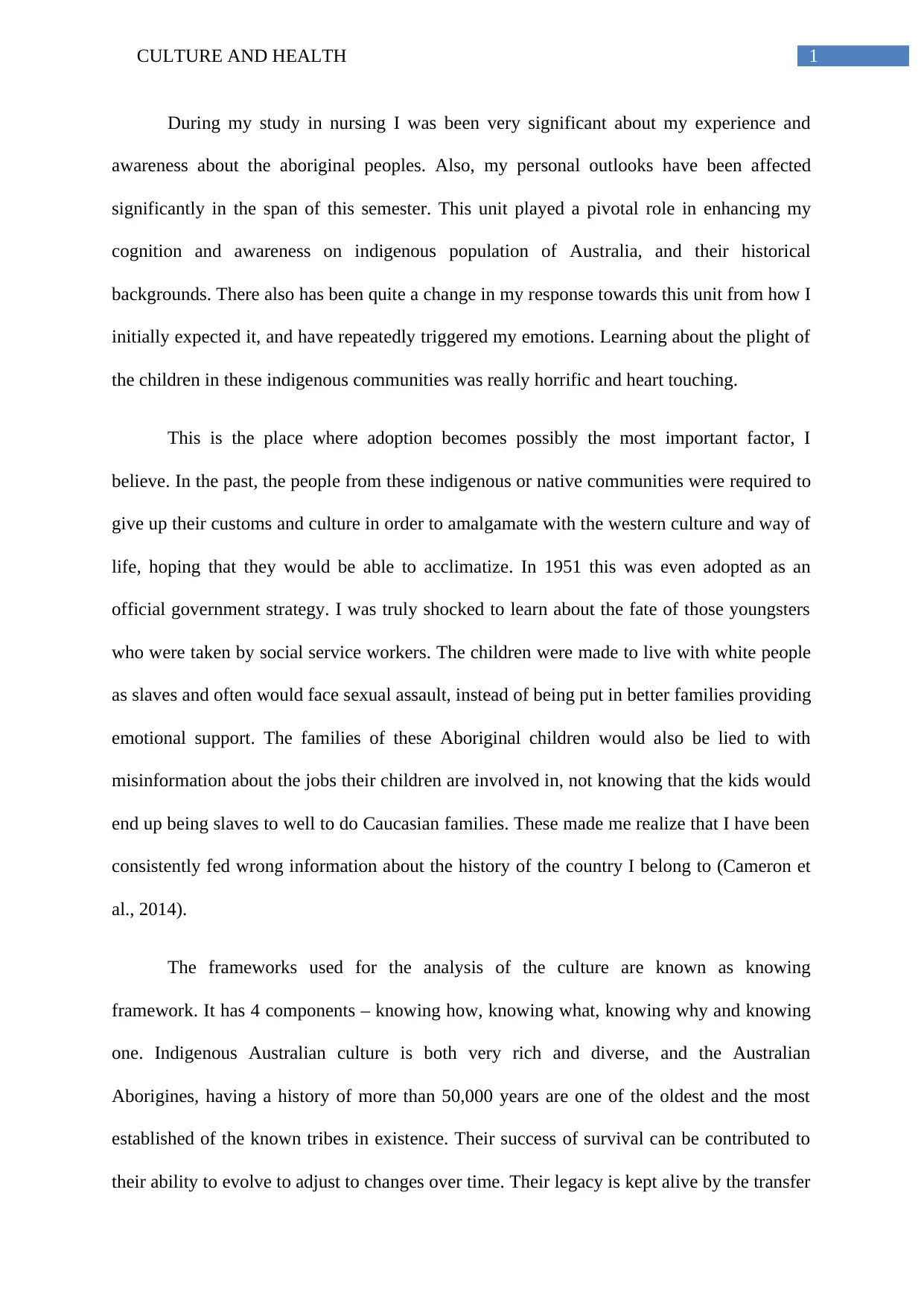
1CULTURE AND HEALTH
During my study in nursing I was been very significant about my experience and
awareness about the aboriginal peoples. Also, my personal outlooks have been affected
significantly in the span of this semester. This unit played a pivotal role in enhancing my
cognition and awareness on indigenous population of Australia, and their historical
backgrounds. There also has been quite a change in my response towards this unit from how I
initially expected it, and have repeatedly triggered my emotions. Learning about the plight of
the children in these indigenous communities was really horrific and heart touching.
This is the place where adoption becomes possibly the most important factor, I
believe. In the past, the people from these indigenous or native communities were required to
give up their customs and culture in order to amalgamate with the western culture and way of
life, hoping that they would be able to acclimatize. In 1951 this was even adopted as an
official government strategy. I was truly shocked to learn about the fate of those youngsters
who were taken by social service workers. The children were made to live with white people
as slaves and often would face sexual assault, instead of being put in better families providing
emotional support. The families of these Aboriginal children would also be lied to with
misinformation about the jobs their children are involved in, not knowing that the kids would
end up being slaves to well to do Caucasian families. These made me realize that I have been
consistently fed wrong information about the history of the country I belong to (Cameron et
al., 2014).
The frameworks used for the analysis of the culture are known as knowing
framework. It has 4 components – knowing how, knowing what, knowing why and knowing
one. Indigenous Australian culture is both very rich and diverse, and the Australian
Aborigines, having a history of more than 50,000 years are one of the oldest and the most
established of the known tribes in existence. Their success of survival can be contributed to
their ability to evolve to adjust to changes over time. Their legacy is kept alive by the transfer
During my study in nursing I was been very significant about my experience and
awareness about the aboriginal peoples. Also, my personal outlooks have been affected
significantly in the span of this semester. This unit played a pivotal role in enhancing my
cognition and awareness on indigenous population of Australia, and their historical
backgrounds. There also has been quite a change in my response towards this unit from how I
initially expected it, and have repeatedly triggered my emotions. Learning about the plight of
the children in these indigenous communities was really horrific and heart touching.
This is the place where adoption becomes possibly the most important factor, I
believe. In the past, the people from these indigenous or native communities were required to
give up their customs and culture in order to amalgamate with the western culture and way of
life, hoping that they would be able to acclimatize. In 1951 this was even adopted as an
official government strategy. I was truly shocked to learn about the fate of those youngsters
who were taken by social service workers. The children were made to live with white people
as slaves and often would face sexual assault, instead of being put in better families providing
emotional support. The families of these Aboriginal children would also be lied to with
misinformation about the jobs their children are involved in, not knowing that the kids would
end up being slaves to well to do Caucasian families. These made me realize that I have been
consistently fed wrong information about the history of the country I belong to (Cameron et
al., 2014).
The frameworks used for the analysis of the culture are known as knowing
framework. It has 4 components – knowing how, knowing what, knowing why and knowing
one. Indigenous Australian culture is both very rich and diverse, and the Australian
Aborigines, having a history of more than 50,000 years are one of the oldest and the most
established of the known tribes in existence. Their success of survival can be contributed to
their ability to evolve to adjust to changes over time. Their legacy is kept alive by the transfer
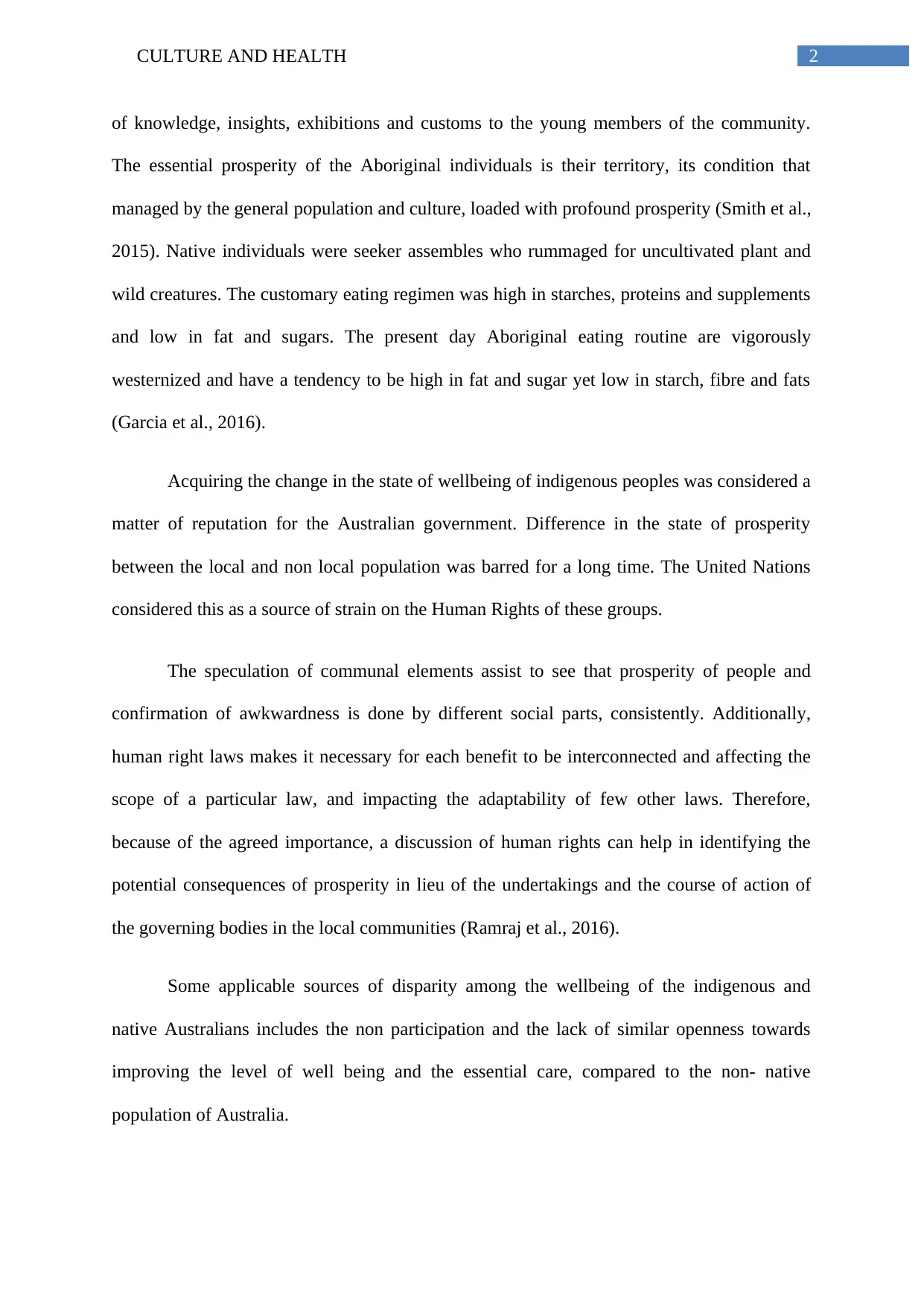
2CULTURE AND HEALTH
of knowledge, insights, exhibitions and customs to the young members of the community.
The essential prosperity of the Aboriginal individuals is their territory, its condition that
managed by the general population and culture, loaded with profound prosperity (Smith et al.,
2015). Native individuals were seeker assembles who rummaged for uncultivated plant and
wild creatures. The customary eating regimen was high in starches, proteins and supplements
and low in fat and sugars. The present day Aboriginal eating routine are vigorously
westernized and have a tendency to be high in fat and sugar yet low in starch, fibre and fats
(Garcia et al., 2016).
Acquiring the change in the state of wellbeing of indigenous peoples was considered a
matter of reputation for the Australian government. Difference in the state of prosperity
between the local and non local population was barred for a long time. The United Nations
considered this as a source of strain on the Human Rights of these groups.
The speculation of communal elements assist to see that prosperity of people and
confirmation of awkwardness is done by different social parts, consistently. Additionally,
human right laws makes it necessary for each benefit to be interconnected and affecting the
scope of a particular law, and impacting the adaptability of few other laws. Therefore,
because of the agreed importance, a discussion of human rights can help in identifying the
potential consequences of prosperity in lieu of the undertakings and the course of action of
the governing bodies in the local communities (Ramraj et al., 2016).
Some applicable sources of disparity among the wellbeing of the indigenous and
native Australians includes the non participation and the lack of similar openness towards
improving the level of well being and the essential care, compared to the non- native
population of Australia.
of knowledge, insights, exhibitions and customs to the young members of the community.
The essential prosperity of the Aboriginal individuals is their territory, its condition that
managed by the general population and culture, loaded with profound prosperity (Smith et al.,
2015). Native individuals were seeker assembles who rummaged for uncultivated plant and
wild creatures. The customary eating regimen was high in starches, proteins and supplements
and low in fat and sugars. The present day Aboriginal eating routine are vigorously
westernized and have a tendency to be high in fat and sugar yet low in starch, fibre and fats
(Garcia et al., 2016).
Acquiring the change in the state of wellbeing of indigenous peoples was considered a
matter of reputation for the Australian government. Difference in the state of prosperity
between the local and non local population was barred for a long time. The United Nations
considered this as a source of strain on the Human Rights of these groups.
The speculation of communal elements assist to see that prosperity of people and
confirmation of awkwardness is done by different social parts, consistently. Additionally,
human right laws makes it necessary for each benefit to be interconnected and affecting the
scope of a particular law, and impacting the adaptability of few other laws. Therefore,
because of the agreed importance, a discussion of human rights can help in identifying the
potential consequences of prosperity in lieu of the undertakings and the course of action of
the governing bodies in the local communities (Ramraj et al., 2016).
Some applicable sources of disparity among the wellbeing of the indigenous and
native Australians includes the non participation and the lack of similar openness towards
improving the level of well being and the essential care, compared to the non- native
population of Australia.
⊘ This is a preview!⊘
Do you want full access?
Subscribe today to unlock all pages.

Trusted by 1+ million students worldwide
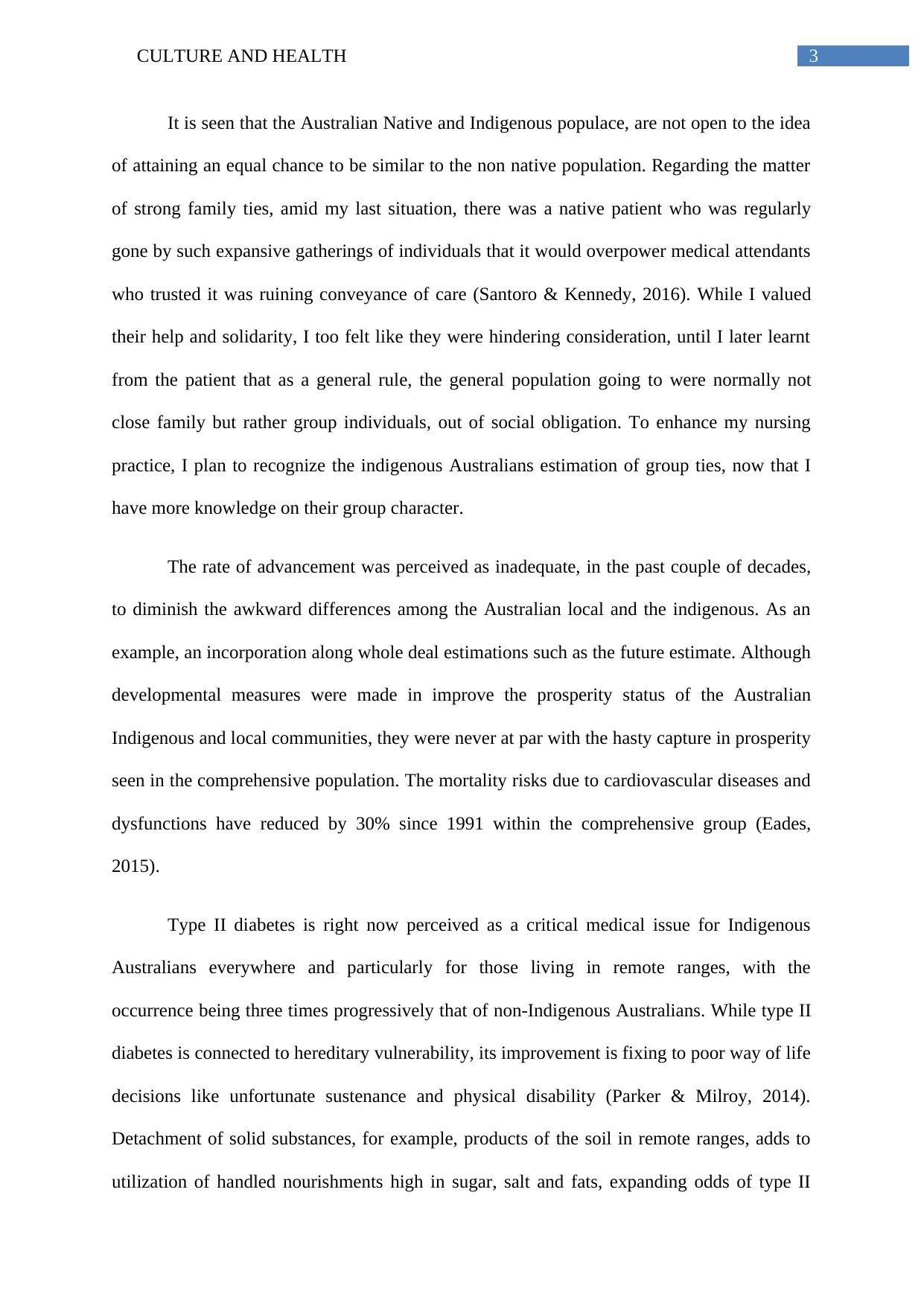
3CULTURE AND HEALTH
It is seen that the Australian Native and Indigenous populace, are not open to the idea
of attaining an equal chance to be similar to the non native population. Regarding the matter
of strong family ties, amid my last situation, there was a native patient who was regularly
gone by such expansive gatherings of individuals that it would overpower medical attendants
who trusted it was ruining conveyance of care (Santoro & Kennedy, 2016). While I valued
their help and solidarity, I too felt like they were hindering consideration, until I later learnt
from the patient that as a general rule, the general population going to were normally not
close family but rather group individuals, out of social obligation. To enhance my nursing
practice, I plan to recognize the indigenous Australians estimation of group ties, now that I
have more knowledge on their group character.
The rate of advancement was perceived as inadequate, in the past couple of decades,
to diminish the awkward differences among the Australian local and the indigenous. As an
example, an incorporation along whole deal estimations such as the future estimate. Although
developmental measures were made in improve the prosperity status of the Australian
Indigenous and local communities, they were never at par with the hasty capture in prosperity
seen in the comprehensive population. The mortality risks due to cardiovascular diseases and
dysfunctions have reduced by 30% since 1991 within the comprehensive group (Eades,
2015).
Type II diabetes is right now perceived as a critical medical issue for Indigenous
Australians everywhere and particularly for those living in remote ranges, with the
occurrence being three times progressively that of non-Indigenous Australians. While type II
diabetes is connected to hereditary vulnerability, its improvement is fixing to poor way of life
decisions like unfortunate sustenance and physical disability (Parker & Milroy, 2014).
Detachment of solid substances, for example, products of the soil in remote ranges, adds to
utilization of handled nourishments high in sugar, salt and fats, expanding odds of type II
It is seen that the Australian Native and Indigenous populace, are not open to the idea
of attaining an equal chance to be similar to the non native population. Regarding the matter
of strong family ties, amid my last situation, there was a native patient who was regularly
gone by such expansive gatherings of individuals that it would overpower medical attendants
who trusted it was ruining conveyance of care (Santoro & Kennedy, 2016). While I valued
their help and solidarity, I too felt like they were hindering consideration, until I later learnt
from the patient that as a general rule, the general population going to were normally not
close family but rather group individuals, out of social obligation. To enhance my nursing
practice, I plan to recognize the indigenous Australians estimation of group ties, now that I
have more knowledge on their group character.
The rate of advancement was perceived as inadequate, in the past couple of decades,
to diminish the awkward differences among the Australian local and the indigenous. As an
example, an incorporation along whole deal estimations such as the future estimate. Although
developmental measures were made in improve the prosperity status of the Australian
Indigenous and local communities, they were never at par with the hasty capture in prosperity
seen in the comprehensive population. The mortality risks due to cardiovascular diseases and
dysfunctions have reduced by 30% since 1991 within the comprehensive group (Eades,
2015).
Type II diabetes is right now perceived as a critical medical issue for Indigenous
Australians everywhere and particularly for those living in remote ranges, with the
occurrence being three times progressively that of non-Indigenous Australians. While type II
diabetes is connected to hereditary vulnerability, its improvement is fixing to poor way of life
decisions like unfortunate sustenance and physical disability (Parker & Milroy, 2014).
Detachment of solid substances, for example, products of the soil in remote ranges, adds to
utilization of handled nourishments high in sugar, salt and fats, expanding odds of type II
Paraphrase This Document
Need a fresh take? Get an instant paraphrase of this document with our AI Paraphraser
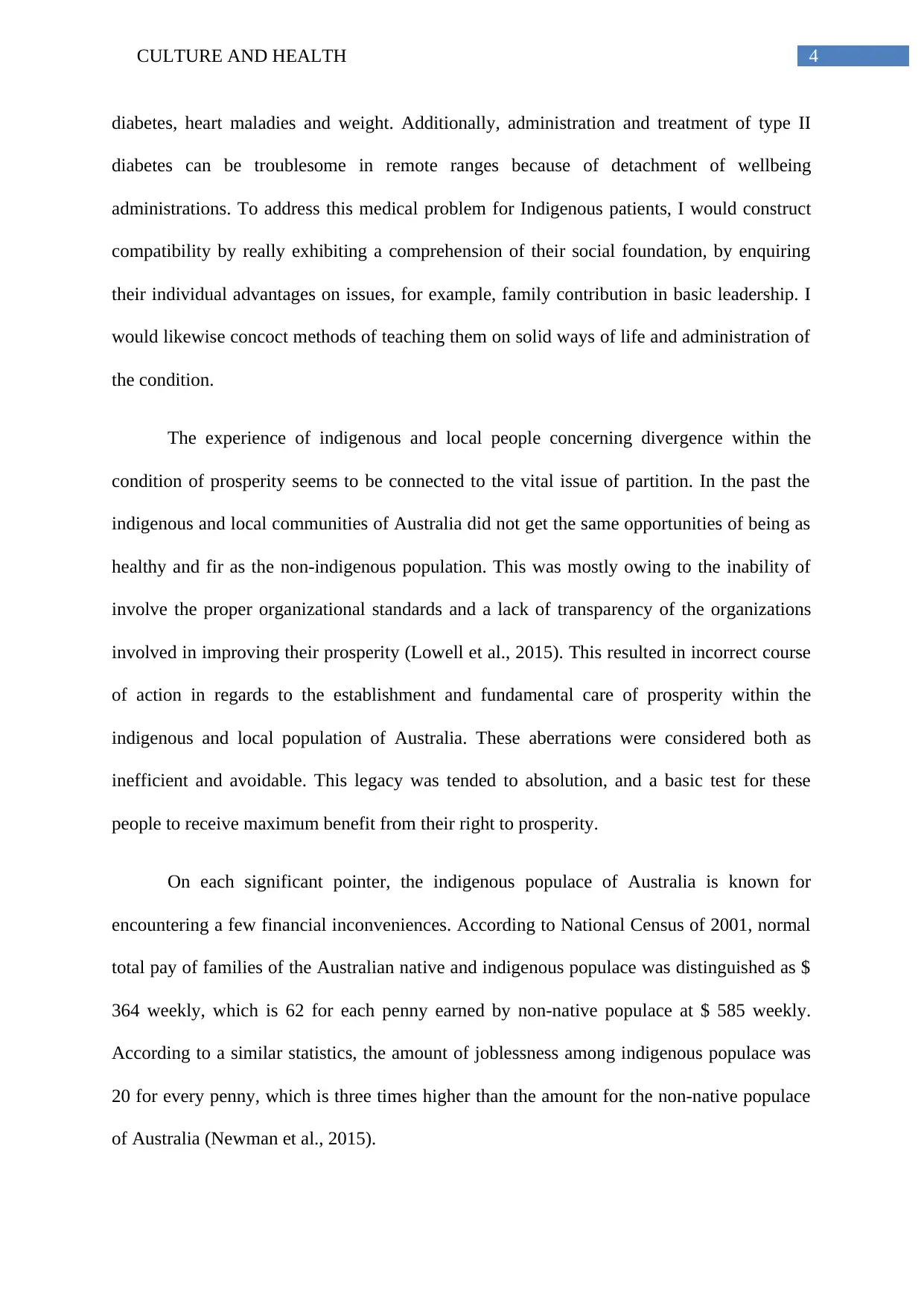
4CULTURE AND HEALTH
diabetes, heart maladies and weight. Additionally, administration and treatment of type II
diabetes can be troublesome in remote ranges because of detachment of wellbeing
administrations. To address this medical problem for Indigenous patients, I would construct
compatibility by really exhibiting a comprehension of their social foundation, by enquiring
their individual advantages on issues, for example, family contribution in basic leadership. I
would likewise concoct methods of teaching them on solid ways of life and administration of
the condition.
The experience of indigenous and local people concerning divergence within the
condition of prosperity seems to be connected to the vital issue of partition. In the past the
indigenous and local communities of Australia did not get the same opportunities of being as
healthy and fir as the non-indigenous population. This was mostly owing to the inability of
involve the proper organizational standards and a lack of transparency of the organizations
involved in improving their prosperity (Lowell et al., 2015). This resulted in incorrect course
of action in regards to the establishment and fundamental care of prosperity within the
indigenous and local population of Australia. These aberrations were considered both as
inefficient and avoidable. This legacy was tended to absolution, and a basic test for these
people to receive maximum benefit from their right to prosperity.
On each significant pointer, the indigenous populace of Australia is known for
encountering a few financial inconveniences. According to National Census of 2001, normal
total pay of families of the Australian native and indigenous populace was distinguished as $
364 weekly, which is 62 for each penny earned by non-native populace at $ 585 weekly.
According to a similar statistics, the amount of joblessness among indigenous populace was
20 for every penny, which is three times higher than the amount for the non-native populace
of Australia (Newman et al., 2015).
diabetes, heart maladies and weight. Additionally, administration and treatment of type II
diabetes can be troublesome in remote ranges because of detachment of wellbeing
administrations. To address this medical problem for Indigenous patients, I would construct
compatibility by really exhibiting a comprehension of their social foundation, by enquiring
their individual advantages on issues, for example, family contribution in basic leadership. I
would likewise concoct methods of teaching them on solid ways of life and administration of
the condition.
The experience of indigenous and local people concerning divergence within the
condition of prosperity seems to be connected to the vital issue of partition. In the past the
indigenous and local communities of Australia did not get the same opportunities of being as
healthy and fir as the non-indigenous population. This was mostly owing to the inability of
involve the proper organizational standards and a lack of transparency of the organizations
involved in improving their prosperity (Lowell et al., 2015). This resulted in incorrect course
of action in regards to the establishment and fundamental care of prosperity within the
indigenous and local population of Australia. These aberrations were considered both as
inefficient and avoidable. This legacy was tended to absolution, and a basic test for these
people to receive maximum benefit from their right to prosperity.
On each significant pointer, the indigenous populace of Australia is known for
encountering a few financial inconveniences. According to National Census of 2001, normal
total pay of families of the Australian native and indigenous populace was distinguished as $
364 weekly, which is 62 for each penny earned by non-native populace at $ 585 weekly.
According to a similar statistics, the amount of joblessness among indigenous populace was
20 for every penny, which is three times higher than the amount for the non-native populace
of Australia (Newman et al., 2015).
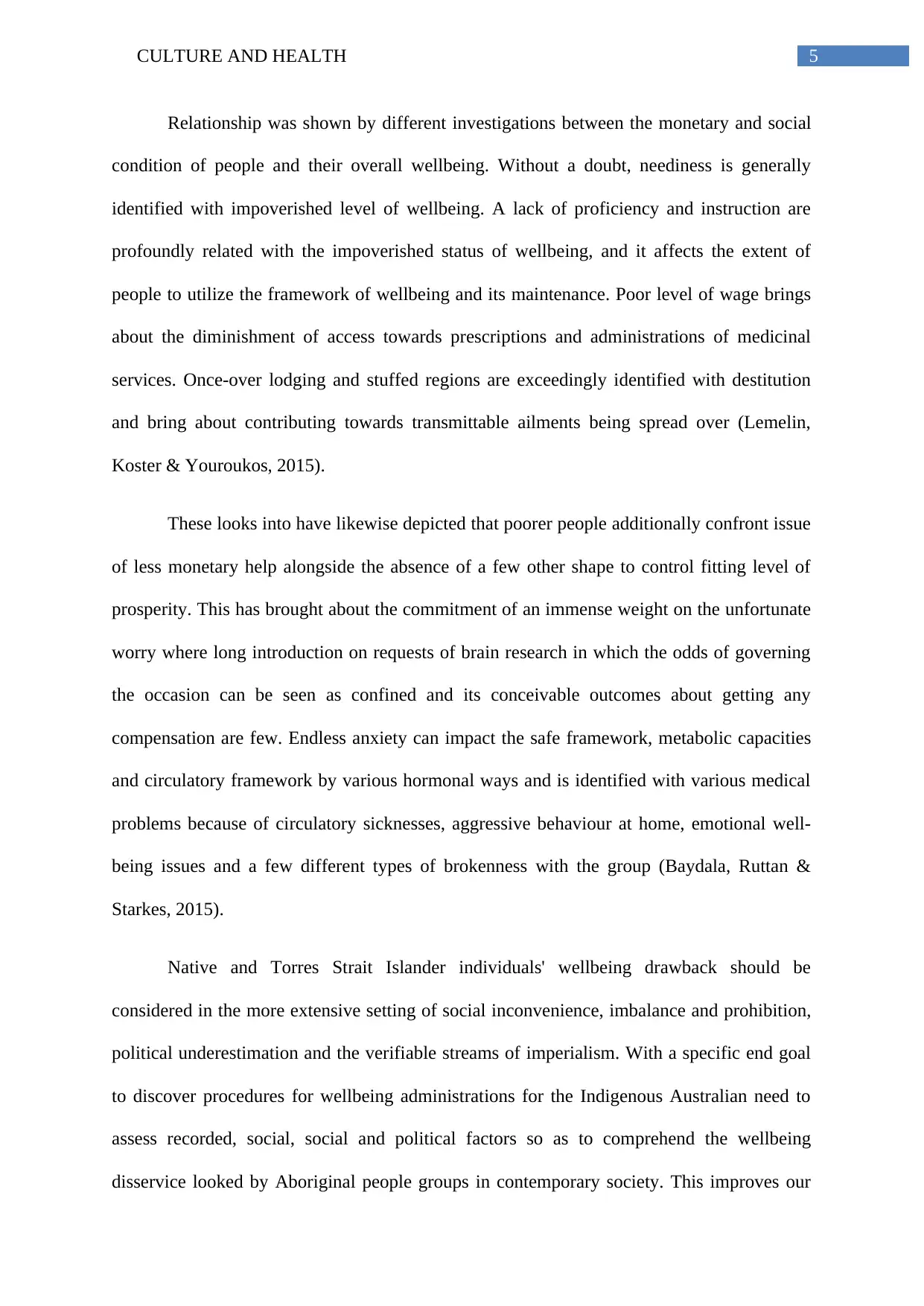
5CULTURE AND HEALTH
Relationship was shown by different investigations between the monetary and social
condition of people and their overall wellbeing. Without a doubt, neediness is generally
identified with impoverished level of wellbeing. A lack of proficiency and instruction are
profoundly related with the impoverished status of wellbeing, and it affects the extent of
people to utilize the framework of wellbeing and its maintenance. Poor level of wage brings
about the diminishment of access towards prescriptions and administrations of medicinal
services. Once-over lodging and stuffed regions are exceedingly identified with destitution
and bring about contributing towards transmittable ailments being spread over (Lemelin,
Koster & Youroukos, 2015).
These looks into have likewise depicted that poorer people additionally confront issue
of less monetary help alongside the absence of a few other shape to control fitting level of
prosperity. This has brought about the commitment of an immense weight on the unfortunate
worry where long introduction on requests of brain research in which the odds of governing
the occasion can be seen as confined and its conceivable outcomes about getting any
compensation are few. Endless anxiety can impact the safe framework, metabolic capacities
and circulatory framework by various hormonal ways and is identified with various medical
problems because of circulatory sicknesses, aggressive behaviour at home, emotional well-
being issues and a few different types of brokenness with the group (Baydala, Ruttan &
Starkes, 2015).
Native and Torres Strait Islander individuals' wellbeing drawback should be
considered in the more extensive setting of social inconvenience, imbalance and prohibition,
political underestimation and the verifiable streams of imperialism. With a specific end goal
to discover procedures for wellbeing administrations for the Indigenous Australian need to
assess recorded, social, social and political factors so as to comprehend the wellbeing
disservice looked by Aboriginal people groups in contemporary society. This improves our
Relationship was shown by different investigations between the monetary and social
condition of people and their overall wellbeing. Without a doubt, neediness is generally
identified with impoverished level of wellbeing. A lack of proficiency and instruction are
profoundly related with the impoverished status of wellbeing, and it affects the extent of
people to utilize the framework of wellbeing and its maintenance. Poor level of wage brings
about the diminishment of access towards prescriptions and administrations of medicinal
services. Once-over lodging and stuffed regions are exceedingly identified with destitution
and bring about contributing towards transmittable ailments being spread over (Lemelin,
Koster & Youroukos, 2015).
These looks into have likewise depicted that poorer people additionally confront issue
of less monetary help alongside the absence of a few other shape to control fitting level of
prosperity. This has brought about the commitment of an immense weight on the unfortunate
worry where long introduction on requests of brain research in which the odds of governing
the occasion can be seen as confined and its conceivable outcomes about getting any
compensation are few. Endless anxiety can impact the safe framework, metabolic capacities
and circulatory framework by various hormonal ways and is identified with various medical
problems because of circulatory sicknesses, aggressive behaviour at home, emotional well-
being issues and a few different types of brokenness with the group (Baydala, Ruttan &
Starkes, 2015).
Native and Torres Strait Islander individuals' wellbeing drawback should be
considered in the more extensive setting of social inconvenience, imbalance and prohibition,
political underestimation and the verifiable streams of imperialism. With a specific end goal
to discover procedures for wellbeing administrations for the Indigenous Australian need to
assess recorded, social, social and political factors so as to comprehend the wellbeing
disservice looked by Aboriginal people groups in contemporary society. This improves our
⊘ This is a preview!⊘
Do you want full access?
Subscribe today to unlock all pages.

Trusted by 1+ million students worldwide
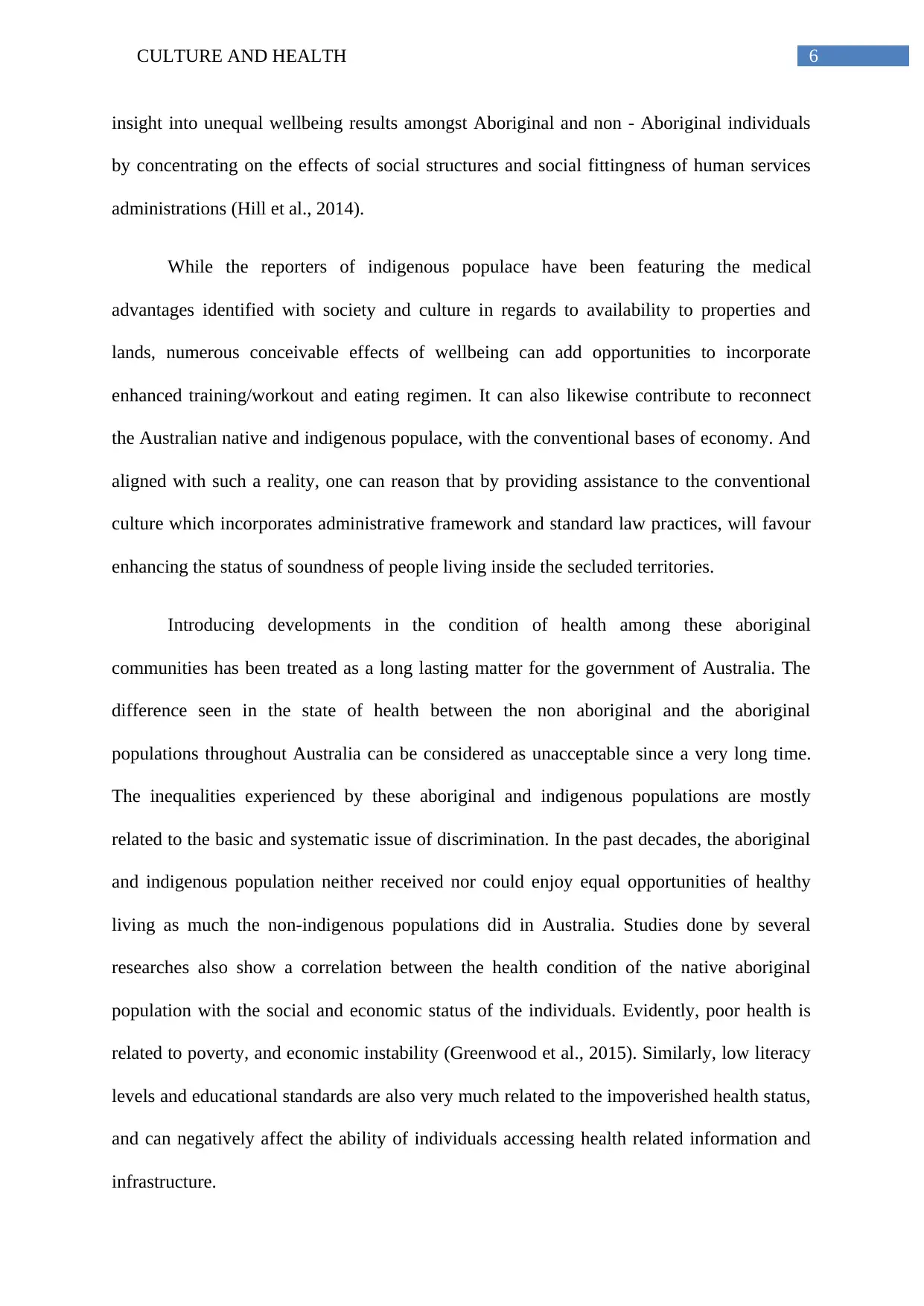
6CULTURE AND HEALTH
insight into unequal wellbeing results amongst Aboriginal and non - Aboriginal individuals
by concentrating on the effects of social structures and social fittingness of human services
administrations (Hill et al., 2014).
While the reporters of indigenous populace have been featuring the medical
advantages identified with society and culture in regards to availability to properties and
lands, numerous conceivable effects of wellbeing can add opportunities to incorporate
enhanced training/workout and eating regimen. It can also likewise contribute to reconnect
the Australian native and indigenous populace, with the conventional bases of economy. And
aligned with such a reality, one can reason that by providing assistance to the conventional
culture which incorporates administrative framework and standard law practices, will favour
enhancing the status of soundness of people living inside the secluded territories.
Introducing developments in the condition of health among these aboriginal
communities has been treated as a long lasting matter for the government of Australia. The
difference seen in the state of health between the non aboriginal and the aboriginal
populations throughout Australia can be considered as unacceptable since a very long time.
The inequalities experienced by these aboriginal and indigenous populations are mostly
related to the basic and systematic issue of discrimination. In the past decades, the aboriginal
and indigenous population neither received nor could enjoy equal opportunities of healthy
living as much the non-indigenous populations did in Australia. Studies done by several
researches also show a correlation between the health condition of the native aboriginal
population with the social and economic status of the individuals. Evidently, poor health is
related to poverty, and economic instability (Greenwood et al., 2015). Similarly, low literacy
levels and educational standards are also very much related to the impoverished health status,
and can negatively affect the ability of individuals accessing health related information and
infrastructure.
insight into unequal wellbeing results amongst Aboriginal and non - Aboriginal individuals
by concentrating on the effects of social structures and social fittingness of human services
administrations (Hill et al., 2014).
While the reporters of indigenous populace have been featuring the medical
advantages identified with society and culture in regards to availability to properties and
lands, numerous conceivable effects of wellbeing can add opportunities to incorporate
enhanced training/workout and eating regimen. It can also likewise contribute to reconnect
the Australian native and indigenous populace, with the conventional bases of economy. And
aligned with such a reality, one can reason that by providing assistance to the conventional
culture which incorporates administrative framework and standard law practices, will favour
enhancing the status of soundness of people living inside the secluded territories.
Introducing developments in the condition of health among these aboriginal
communities has been treated as a long lasting matter for the government of Australia. The
difference seen in the state of health between the non aboriginal and the aboriginal
populations throughout Australia can be considered as unacceptable since a very long time.
The inequalities experienced by these aboriginal and indigenous populations are mostly
related to the basic and systematic issue of discrimination. In the past decades, the aboriginal
and indigenous population neither received nor could enjoy equal opportunities of healthy
living as much the non-indigenous populations did in Australia. Studies done by several
researches also show a correlation between the health condition of the native aboriginal
population with the social and economic status of the individuals. Evidently, poor health is
related to poverty, and economic instability (Greenwood et al., 2015). Similarly, low literacy
levels and educational standards are also very much related to the impoverished health status,
and can negatively affect the ability of individuals accessing health related information and
infrastructure.
Paraphrase This Document
Need a fresh take? Get an instant paraphrase of this document with our AI Paraphraser
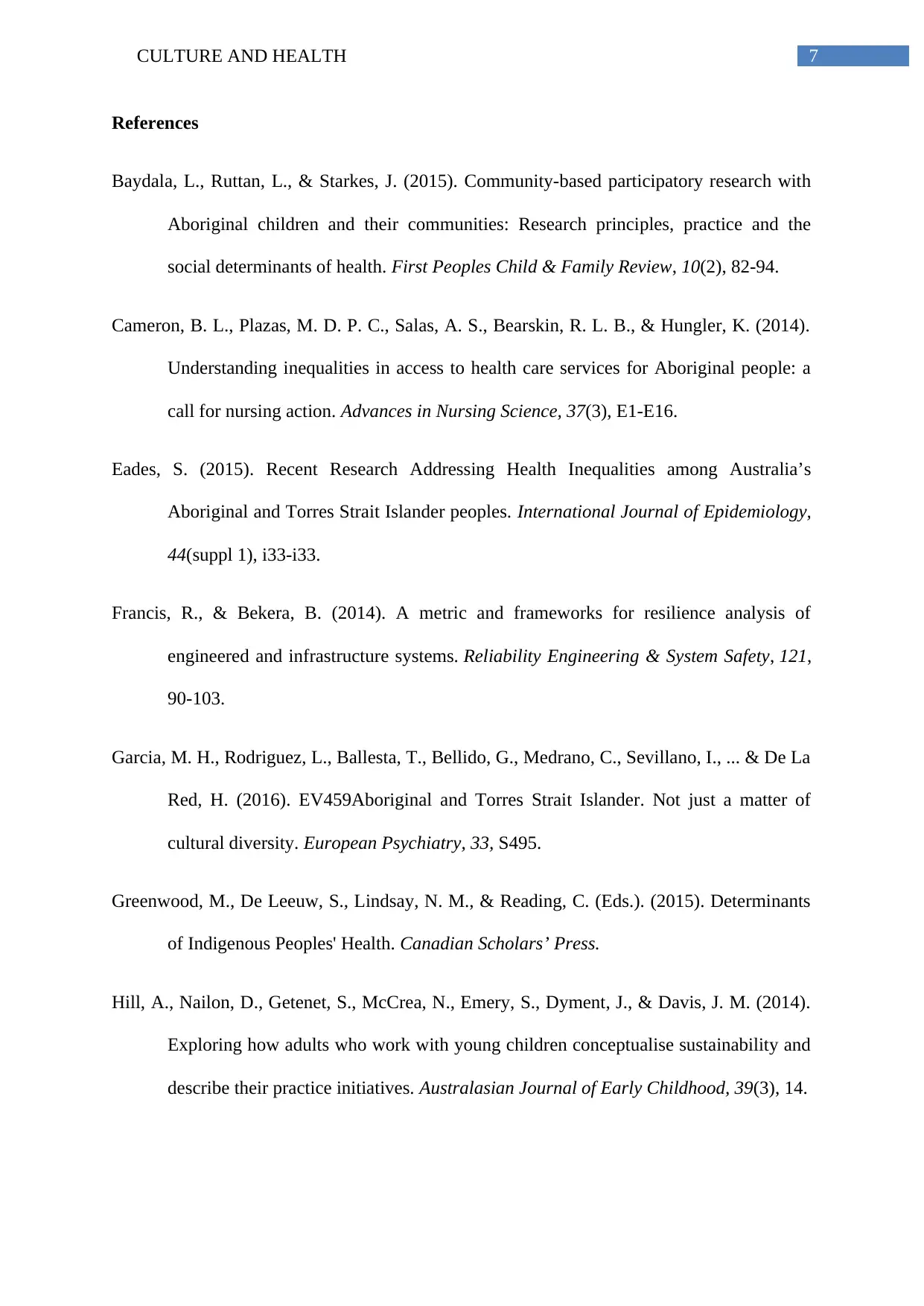
7CULTURE AND HEALTH
References
Baydala, L., Ruttan, L., & Starkes, J. (2015). Community-based participatory research with
Aboriginal children and their communities: Research principles, practice and the
social determinants of health. First Peoples Child & Family Review, 10(2), 82-94.
Cameron, B. L., Plazas, M. D. P. C., Salas, A. S., Bearskin, R. L. B., & Hungler, K. (2014).
Understanding inequalities in access to health care services for Aboriginal people: a
call for nursing action. Advances in Nursing Science, 37(3), E1-E16.
Eades, S. (2015). Recent Research Addressing Health Inequalities among Australia’s
Aboriginal and Torres Strait Islander peoples. International Journal of Epidemiology,
44(suppl 1), i33-i33.
Francis, R., & Bekera, B. (2014). A metric and frameworks for resilience analysis of
engineered and infrastructure systems. Reliability Engineering & System Safety, 121,
90-103.
Garcia, M. H., Rodriguez, L., Ballesta, T., Bellido, G., Medrano, C., Sevillano, I., ... & De La
Red, H. (2016). EV459Aboriginal and Torres Strait Islander. Not just a matter of
cultural diversity. European Psychiatry, 33, S495.
Greenwood, M., De Leeuw, S., Lindsay, N. M., & Reading, C. (Eds.). (2015). Determinants
of Indigenous Peoples' Health. Canadian Scholars’ Press.
Hill, A., Nailon, D., Getenet, S., McCrea, N., Emery, S., Dyment, J., & Davis, J. M. (2014).
Exploring how adults who work with young children conceptualise sustainability and
describe their practice initiatives. Australasian Journal of Early Childhood, 39(3), 14.
References
Baydala, L., Ruttan, L., & Starkes, J. (2015). Community-based participatory research with
Aboriginal children and their communities: Research principles, practice and the
social determinants of health. First Peoples Child & Family Review, 10(2), 82-94.
Cameron, B. L., Plazas, M. D. P. C., Salas, A. S., Bearskin, R. L. B., & Hungler, K. (2014).
Understanding inequalities in access to health care services for Aboriginal people: a
call for nursing action. Advances in Nursing Science, 37(3), E1-E16.
Eades, S. (2015). Recent Research Addressing Health Inequalities among Australia’s
Aboriginal and Torres Strait Islander peoples. International Journal of Epidemiology,
44(suppl 1), i33-i33.
Francis, R., & Bekera, B. (2014). A metric and frameworks for resilience analysis of
engineered and infrastructure systems. Reliability Engineering & System Safety, 121,
90-103.
Garcia, M. H., Rodriguez, L., Ballesta, T., Bellido, G., Medrano, C., Sevillano, I., ... & De La
Red, H. (2016). EV459Aboriginal and Torres Strait Islander. Not just a matter of
cultural diversity. European Psychiatry, 33, S495.
Greenwood, M., De Leeuw, S., Lindsay, N. M., & Reading, C. (Eds.). (2015). Determinants
of Indigenous Peoples' Health. Canadian Scholars’ Press.
Hill, A., Nailon, D., Getenet, S., McCrea, N., Emery, S., Dyment, J., & Davis, J. M. (2014).
Exploring how adults who work with young children conceptualise sustainability and
describe their practice initiatives. Australasian Journal of Early Childhood, 39(3), 14.
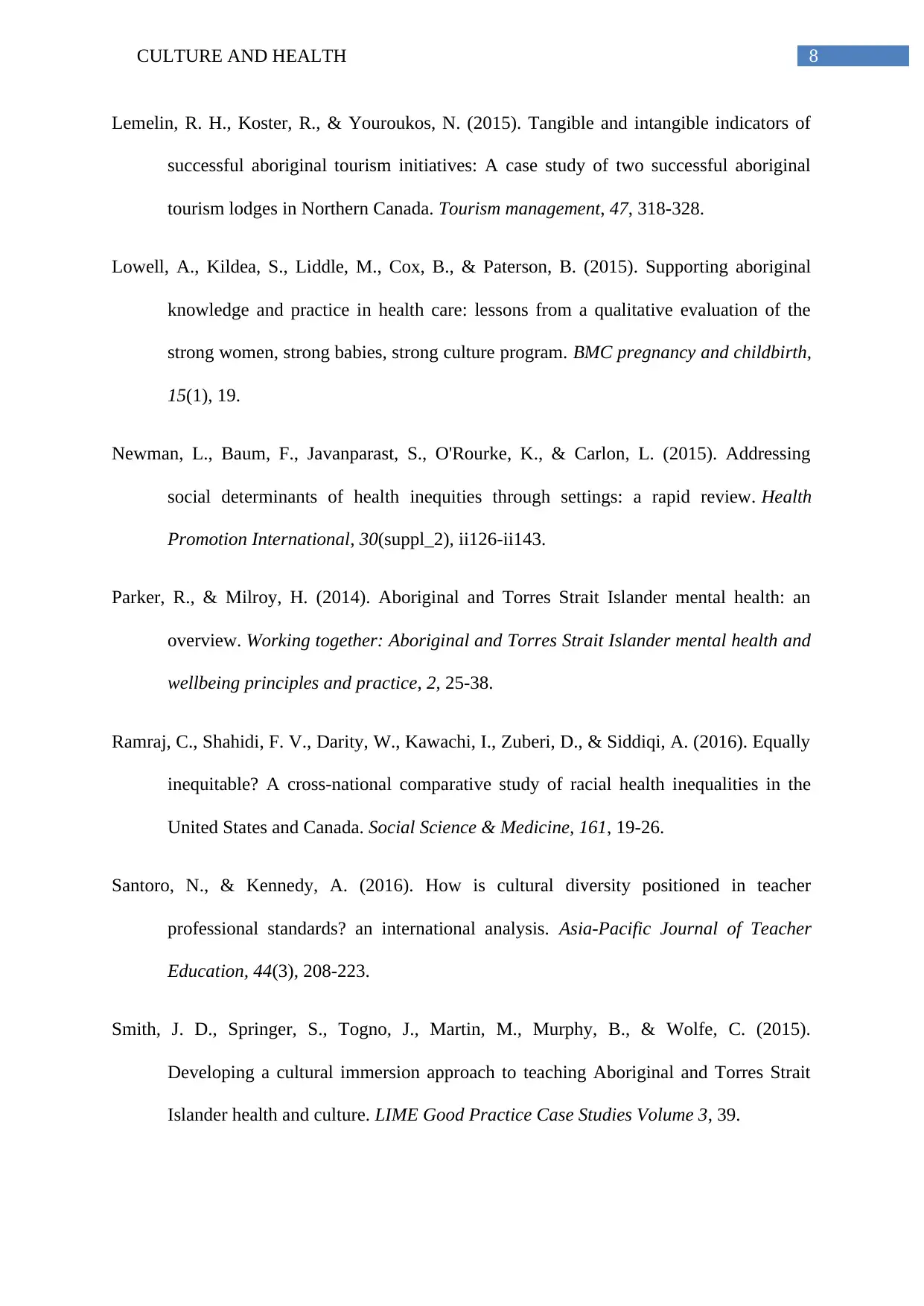
8CULTURE AND HEALTH
Lemelin, R. H., Koster, R., & Youroukos, N. (2015). Tangible and intangible indicators of
successful aboriginal tourism initiatives: A case study of two successful aboriginal
tourism lodges in Northern Canada. Tourism management, 47, 318-328.
Lowell, A., Kildea, S., Liddle, M., Cox, B., & Paterson, B. (2015). Supporting aboriginal
knowledge and practice in health care: lessons from a qualitative evaluation of the
strong women, strong babies, strong culture program. BMC pregnancy and childbirth,
15(1), 19.
Newman, L., Baum, F., Javanparast, S., O'Rourke, K., & Carlon, L. (2015). Addressing
social determinants of health inequities through settings: a rapid review. Health
Promotion International, 30(suppl_2), ii126-ii143.
Parker, R., & Milroy, H. (2014). Aboriginal and Torres Strait Islander mental health: an
overview. Working together: Aboriginal and Torres Strait Islander mental health and
wellbeing principles and practice, 2, 25-38.
Ramraj, C., Shahidi, F. V., Darity, W., Kawachi, I., Zuberi, D., & Siddiqi, A. (2016). Equally
inequitable? A cross-national comparative study of racial health inequalities in the
United States and Canada. Social Science & Medicine, 161, 19-26.
Santoro, N., & Kennedy, A. (2016). How is cultural diversity positioned in teacher
professional standards? an international analysis. Asia-Pacific Journal of Teacher
Education, 44(3), 208-223.
Smith, J. D., Springer, S., Togno, J., Martin, M., Murphy, B., & Wolfe, C. (2015).
Developing a cultural immersion approach to teaching Aboriginal and Torres Strait
Islander health and culture. LIME Good Practice Case Studies Volume 3, 39.
Lemelin, R. H., Koster, R., & Youroukos, N. (2015). Tangible and intangible indicators of
successful aboriginal tourism initiatives: A case study of two successful aboriginal
tourism lodges in Northern Canada. Tourism management, 47, 318-328.
Lowell, A., Kildea, S., Liddle, M., Cox, B., & Paterson, B. (2015). Supporting aboriginal
knowledge and practice in health care: lessons from a qualitative evaluation of the
strong women, strong babies, strong culture program. BMC pregnancy and childbirth,
15(1), 19.
Newman, L., Baum, F., Javanparast, S., O'Rourke, K., & Carlon, L. (2015). Addressing
social determinants of health inequities through settings: a rapid review. Health
Promotion International, 30(suppl_2), ii126-ii143.
Parker, R., & Milroy, H. (2014). Aboriginal and Torres Strait Islander mental health: an
overview. Working together: Aboriginal and Torres Strait Islander mental health and
wellbeing principles and practice, 2, 25-38.
Ramraj, C., Shahidi, F. V., Darity, W., Kawachi, I., Zuberi, D., & Siddiqi, A. (2016). Equally
inequitable? A cross-national comparative study of racial health inequalities in the
United States and Canada. Social Science & Medicine, 161, 19-26.
Santoro, N., & Kennedy, A. (2016). How is cultural diversity positioned in teacher
professional standards? an international analysis. Asia-Pacific Journal of Teacher
Education, 44(3), 208-223.
Smith, J. D., Springer, S., Togno, J., Martin, M., Murphy, B., & Wolfe, C. (2015).
Developing a cultural immersion approach to teaching Aboriginal and Torres Strait
Islander health and culture. LIME Good Practice Case Studies Volume 3, 39.
⊘ This is a preview!⊘
Do you want full access?
Subscribe today to unlock all pages.

Trusted by 1+ million students worldwide
1 out of 9
Related Documents
Your All-in-One AI-Powered Toolkit for Academic Success.
+13062052269
info@desklib.com
Available 24*7 on WhatsApp / Email
![[object Object]](/_next/static/media/star-bottom.7253800d.svg)
Unlock your academic potential
Copyright © 2020–2025 A2Z Services. All Rights Reserved. Developed and managed by ZUCOL.





